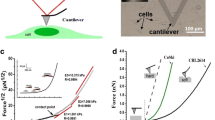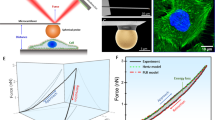Abstract
Though the pharmacological activity of curcumin inhibiting the proliferation of certain cancer cells in culture was demonstrated, its effect on early-stage modifications induced in cell mechanics influencing hereby cell growth and cell adhesion are still questionable. We investigate the morphology and the elastic properties of live cultured, non-malignant human mammalian epithelial cells (HMEC) and cancerous breast epithelial cells (MCF7) by atomic force microscopy. We describe the different behavior of the two similar cell lines under curcumin treatment and we use fluorescence microscopy to identify the microtubules as the cytoskeleton structures responding to curcumin. The first changes in the HMEC cell morphology are observed after already 2 h incubation with curcumin. A 6-h long treatment leaves the MCF7 cells morphology non-affected, but the microtubules of HMEC cells disassemble and form a ring-like organization circumscribing the nuclear area. The observed morphological changes were correlated to modifications in cell’s mechanics via elasticity force mapping measurements. Curcumin treatment modified elasticity of the HMEC cells increasing the cell’s average Young’s modulus two- to threefold, especially in the cytoplasmic area. Contrariwise, a slight decrease in the Young’s modulus was noticed for the MCF7 cells, as they become softer due to the action of curcumin. Chemotherapeutic drugs exert their effect via the perturbation of the dynamic instability of the microtubule, hence the cell-specific perturbation induced by curcumin can help in future understanding of drug induced events on the cell behavior.










Similar content being viewed by others
References
Lekka, M., Laidler, P., Gil, D., Lekki, J., Stachura, Z., & Hrynkiewicz, A. Z. (1999). Elasticity of normal and cancerous human bladder cells studied by scanning force microscopy. European Biophysics Journal, 28, 312–316.
Lekka, M., Lekki, J., Marszałek, M., Golonka, P., Stachura, Z., Cleff, B., et al. (1999). Local elastic properties of cells studied by SFM. Applied Surface Science, 141, 345–349.
Berdyyeva, T. K., Woodworth, C. D., & Sokolov, I. (2005). Human epithelial cells increase their rigidity with ageing in vitro: Direct measurements. Physics in Medicine and Biology, 50, 81–92.
Yamazaki, D., Kurisu, S., & Takenawa, T. (2005). Regulation of cancer cell motility through actin reorganization. Cancer Science, 96, 379–386.
Rao, J., & Li, N. (2004). Microfilament actin remodeling as a potential target for cancer drug development. Current Cancer Drug Targets, 4, 267–283.
Goldmann, W. H., & Ezzell, R. M. (1996). Viscoelasticity in wild-type and vinculin-deficient (5.51) mouse F9 embryonic carcinoma cells examined by atomic force microscopy and rheology. Experimental Cell Research, 1996(226), 234–237.
Goldmann, W. H., Galneder, R., Ludwig, M., Xu, W. M., Adamson, E. D., Wang, N., et al. (1998). Differences in elasticity of vinculin-deficient F9 cells measured by magnetometry and atomic force microscopy. Experimental Cell Research, 239, 235–242.
Discher, D., Janmey, P., & Wang, Y. (2005). Tissue cells feel and respond to the stiffness of their substrate. Science, 310, 1139–1143.
McKnight, A. L., Kugel, J. L., Rossman, P. J., Manduca, A., Hartmann, L. C., & Ehman, R. L. (2002). MR elastography of breast cancer: Preliminary results. American Journal of Roentgenology, 178, 1411–1417.
Bercoff, J., Chaffaï, S., Tanter, M., Sandrin, L., Catheline, S., Fink, M., et al. (2003). In vivo breast tumor detection using transient elastography. Ultrasound in Medicine and Biology, 29, 1387–1396.
Rotsch, C., & Radmacher, M. (2000). Drug-induced changes of cytoskeletal structure and mechanics in fibroblasts: An atomic force microscopy study. Biophysical Journal, 78, 520–535.
Suresh, S., Spatz, J., Mills, J. P., Micoulet, A., Dao, M., Lim, C. T., et al. (2005). Connections between single-cell biomechanics and human disease states: Gastrointestinal cancer and malaria. Acta Biomaterialia, 1, 15–30.
Guck, J., Schinkinger, S., Lincoln, B., Wottawah, F., Ebert, S., Romeyke, M., et al. (2005). Optical deformability as an inherent cell marker for testing malignant transformation and metastatic competence. Biophysical Journal, 88, 3689–3698.
Suresh, S. (2007). Biomechanics and biophysics of cancer cell. Acta Biomaterialia, 3, 413–438.
Cross, S. E., Jin, Y. S., Rao, J., & Gimzewski, J. K. (2007). Nanomechanical analysis of cells from cancer patients. Nature Nanotechnology, 2, 780–783.
Binnig, G., Quate, C. F., & Gerber, C. (1986). Atomic force microscope. Physical Review Letters, 56, 930–933.
Radmacher, M., Tillamnn, R. W., Fritz, M., & Gaub, H. E. (1992). From molecules to cells: Imaging soft samples with the atomic force microscope. Science, 257, 1900–1905.
Hansma, P. K., Elings, V. B., Marti, O., & Bracker, C. E. (1988). Scanning tunneling microscopy and atomic force microscopy: Application to biology and technology. Science, 242, 209–216.
Domke, J., Danno, S., Parak, W. J., Muller, O., Aicher, W. K., & Radmacher, M. (2000). Substrate dependent differences in morphology and elasticity of living osteoblasts investigated by atomic force microscopy. Colloid Surface B., 19, 367–379.
Hertz, H. (1881). Über die Berührung fester elastischer Körper. J Reine Angew Math, 92, 156–171.
Charras, G. T., & Horton, M. A. (2002). Single cell mechanotransduction and its modulation analyzed by atomic force microscopy indentation. Biophysical Journal, 2002(82), 2970–2981.
Dufrene, Y. F. (2002). Atomic force microscopy, a powerful tool in microbiology. Journal of Bacteriology, 2002(184), 5205–5213.
Balint, Z., Krizbai, I. A., Wilhelm, I., Farkas, A. E., Parducz, A., Szegletes, Z., et al. (2007). Changes induced by hyperosmotic mannitol in cerebral endothelial cells: An atomic force microscopic study. European Biophysics Journal, 36, 113–120.
Rotsch, C., Braet, F., Wisse, E., & Radmacher, M. (1997). AFM imaging and elasticity measurements on living rat liver macrophages. Cell Biology International, 21, 685–696.
Aggarwal, B. B., & Shishodia, S. (2006). Molecular targets of dietary agents for prevention and therapy of cancer. Biochemical Pharmacology, 2006(71), 1397–1421.
Choi, H., Chun, Y. S., Kim, S. W., Kim, M. S., & Park, J. W. (2006). Curcumin inhibits hypoxia-inducible factor-1 by degrading aryl hydrocarbon receptor nuclear translocator: A mechanism of tumor growth inhibition. Molecular Pharmacology, 70, 1664–1671.
Shukla, P. K., Khanna, V. K., Ali, M. M., Khan, M. Y., & Srimal, R. (2008). CAnti-ischemic effect of curcumin in rat brain. Neurochemical Research, 33, 1036–1043.
Stix, G. (2007). Spice healer. Scientific American, 296, 66–69.
Shukla, P. K., Khanna, V. K., Khan, M. Y., & Srimal, R. C. (2003). Protective effect of curcumin against lead neurotoxicity in rat. Human and Experimental Toxicology, 22, 653–658.
Jutooru, I., Chadalapaka, G., Lei, P., & Safe, S. (2010). Inhibition of NFKB and pancreatic cancer cell and tumor growth by curcumin is independent on specificity protein down-regulation. Journal of Biological Chemistry, 285, 25332–25344.
Sluzarc, A., Shenouda, N. S., Sakla, M. S., Drenkhaln, S. K., Narula, A. S., MacDonald, R. S., et al. (2010). Common botanical compounds inhibit the Hedgehog signalling pathway in prostate cancer. Cancer Research, 70, 3382–3390.
Dupont-Gillain, Ch. C., Pamula, E., Denis, F. A., De Cupere, V. M., Dufrene, Y. F., & Rouxhet, P. G. (2004). Controlling the supramolecular organisation of adsorbed collagen layers. Journal of Material Science Materials in Medicine, 15, 347–353.
Johnson, K. L. (1994). Contact mechanics. Cambridge: Cambridge University Press.
Gupta, K. K., Bharne, S. S., Rathinasamy, K., Naik, N. R., & Panda, D. (2006). Dietary antioxidant curcumin inhibits microtubule assembly through tubulin binding. FEBS Journal, 273, 5320–5332.
Holy, J. M. (2002). Curcumin disrupts mitotic spindle structure and induces micronucleation in MCF-7 breast cancer cells. Mutation Research, 2002(518), 71–84.
Bannerjee, M., Singh, P., & Panda, D. (2010). Curcumin suppresses the dynamic instability of microtubules, activates the mitotic checkpoint and induces apoptosis in MCF-7 cells. FEBS Journal, 277, 3437–3448.
Larroque, C., Lacroix, B., Galeotti, N., & Jouin, P. (2005). Quantitative and qualitative analysis of tubulin isoforms by mass spectrometry. Molecular and Cell Proteomics., 4, s324.
Bec, N., Lacroix, B., Jouin, P., & Larroque, C. (2006). Study of the native microtubule proteome by MALDI-TOF MS. Molecular and Cell Proteomics., 2006(5), s303.
Saab, M. B., Estephan, E., Bec, N., Larroque, M., Aulombard, R., Cloitre, T., et al. (2011). Multi-microscopic study of curcumin effect on fixed non-malignant and cancerous mammalian epithelial cells. Journal of Biophotonics, 4, 533–543.
Kunwar, A., Barik, A., Mishra, B., Rathinasamy, K., Pandey, R., & Priyadarsini, K. I. (2008). Quantitative cellular uptake, localization and cytotoxicity of curcumin in normal and tumor cells. Biochimica et Biophysica Acta, 1780, 673–679.
Schaaf, C., Shan, B., Buchfelder, M., Losa, M., Kreutzer, J., Rachinger, W., et al. (2009). Curcumin acts as anti-tumorigenic and hormone-suppressive agent in murine and human pituitary tumour cells in vitro and in vivo. Endocrine-Related Cancer, 16, 1339–1350.
Prasanth, R., Nair, G., & Girish, C. M. (2011). Enhanced endocytosis of nano-curcumin in nasopharyngeal cancer cells: An atomic force microscopy study. Applied Physics Letters, 99, 163706. doi:10.1063/1.3653388.
Li, Q. S., Lee, G. Y., Ong, C. N., & Lim, C. T. (2008). AFM indentation study of breast cancer cells. Biochemical and Biophysical Research Communications, 2008(374), 609–613.
Beil, M., Micoulet, A., von Wichert, G., Paschke, S., Walther, P., Omary, M. B., et al. (2003). Sphingosylphosphorylcholine regulates keratin network architecture and visco-elastic properties of human cancer cells. Nature Cell Biology, 2003, 803–811.
Author information
Authors and Affiliations
Corresponding author
Electronic supplementary material
Below is the link to the electronic supplementary material.
Rights and permissions
About this article
Cite this article
Saab, Mb., Bec, N., Martin, M. et al. Differential Effect of Curcumin on the Nanomechanics of Normal and Cancerous Mammalian Epithelial Cells. Cell Biochem Biophys 65, 399–411 (2013). https://doi.org/10.1007/s12013-012-9443-1
Published:
Issue Date:
DOI: https://doi.org/10.1007/s12013-012-9443-1




